
Castles along the Neckar Valley
On the road from Heidelberg along the Neckar valley, perched high on the hilltops and rocky outcrops you’ll find a wealth of castles and ruins lining the river like pearls of medieval monuments. The construction of castles and fortified towns goes back primarily to the Hohenstaufen kings, who secured their imperial territory on the lower Neckar from the early 13th century.
The origins of Heidelberg Castle also date back to the Hohenstaufen period, but the castle fell to the Wittelsbach dynasty, whose territorial policy eventually gave rise to the Electorate of Palatinate, which dominated the lower Neckar valley after the end of the Hohenstaufen dynasty, in fierce competition with the Electorate of Mainz.
Guttenberg Castle near Haßmersheim dates from the early 13th century and belonged to the Lords of Weinsberg as a fiefdom of Worms; with its Greifenwarte and castle museum, it is now a magnet for visitors.
Hirschhorn Castle was built by the Lords of Hirschhorn, and the fortifications of the four-castle town of Neckarsteinach date back to the Lords of Steinach. The smallest of them, Schadeck Castle, was probably built as a counter castle of the Electorate of Mainz. Other lordship relationships led to the construction of Horneck Castle in Gundelsheim and Hornberg Castle above Neckarzimmern or to the mountain fortress of Dilsberg near Neckargemünd.
Count Palatine of the Rhine Ludwig II. von Bayern (1229-1294)
Ludwig’s strong hand did much to put down the robber barons and turn them into a useful defence. All up the valley of the Neckar the hills were studded with fortresses, many of which remain to this day in a more or less ruined condition, the owners of which led an isolated and independent life, owing allegiance to no man, exacting toll from travellers by river or road, harrying the country, and pursuing furious quarrels amongst themselves. At Neckarsteinach there were no less than four, all belonging to the Steinach family; one, perched on a crest commanding the bend of the river and called the Swallows’ Nest, looks like a veritable eyrie of these wild vultures. (from . . Page 37, Heidelberg – Its princes and its palaces – Elizabeth Godfrey)
In all, especially in the mountainous regions of Germany, one sees ruins of the dwellings of our ancestors, a strong race of men who, rough as the air that surrounded them, dwelt on their mountains. High and firm these eagles built their nests. Centuries passed, they crumbled, and their ruins stand before us like images from a mythical world. We look at them with amazement, and they look down earnestly into the valleys, where we sit together and tell ghost stories about them; for to the nervous grandson every great apparition has become ghostly. ( translated from . . . Friedrich Gottschalck – the introduction to his seven-volume work on “Die Ritterburgen und Bergschlösser Deutschlands. ca. 1820.)
Dilsberg a hilltop fortress.
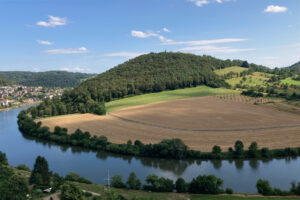 Bergfeste Dilsberg is an imposing high medieval hilltop fortress on the ridge above the Neckar River east of Heidelberg, from which the entire Dilsberg district of the town of Neckargemünd developed. Built by the Counts of Lauffen around 1150 and owned by the Palatine Counts of the Rhine since 1310, today’s castle ruins fulfilled an important military and administrative function for a long time. But the location had its price. Water was a scarce commodity. In order to supply the castle’s inhabitants with water, a 21-meter-deep well was dug.
Bergfeste Dilsberg is an imposing high medieval hilltop fortress on the ridge above the Neckar River east of Heidelberg, from which the entire Dilsberg district of the town of Neckargemünd developed. Built by the Counts of Lauffen around 1150 and owned by the Palatine Counts of the Rhine since 1310, today’s castle ruins fulfilled an important military and administrative function for a long time. But the location had its price. Water was a scarce commodity. In order to supply the castle’s inhabitants with water, a 21-meter-deep well was dug.
In the 14th century, the castle changed hands. From then on, the Pfalzgrafen of the Rhine ruled over the castle. They extended the building: still visible today is the impressive, 16-meter-high shield wall. The ensemble of castle ruins and medieval settlement, which is still preserved in its basic features today, accounts for the special significance of the complex.
During the Thirty Years’ War, the Dilsberg mountain fortress was one of the most contested fortifications. In 1622 it was occupied after a long siege by the imperial troops under Tilly. In 1633 the Swedes recaptured the fortress. Despite siege and fighting, the fortress itself was neither militarily conquered nor destroyed. In 1803, at the end of the Electoral Palatinate, Dilsberg Castle and the associated village fell to the state of Baden and served as a state prison. In 1822 it was released for demolition. The fortress became a source to obtain valuable building material.
At the beginning of the 20th century, the Dilsberg mountain fortress gradually developed into a tourist destination. The castle ruins were extensively renovated and reconstructed. The underground well tunnel rediscovered in 1896. protected workers during the deepening of the well in the 17th century. About 80 meters long, it’s one of the special features of the fortress worth seeing, along with the castle ruins with an observation tower.
Neckarsteinach – Vierburgenstadt

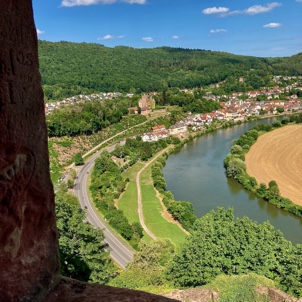 The four-castle town of Neckarsteinach is known for its castles, which are located in the immediate vicinity of each other on a mountain spur or on the slope west of the town. The oldest of the four castles, the Vorderburg (1), must have existed as early as 1142. It is located directly above the old town and is connected to the town wall. It remained in the fiefdom of the Lords of Steinach until 1653. The minnesinger Bligger von Steinach lived here.
The four-castle town of Neckarsteinach is known for its castles, which are located in the immediate vicinity of each other on a mountain spur or on the slope west of the town. The oldest of the four castles, the Vorderburg (1), must have existed as early as 1142. It is located directly above the old town and is connected to the town wall. It remained in the fiefdom of the Lords of Steinach until 1653. The minnesinger Bligger von Steinach lived here.
Some time later, around 1200, the middle castle (2) was built to the west of it. The builders here were probably the counts of Lauffen, who were the feudal lords of the von Steinach. Later, the castle was rebuilt first in Renaissance style, then in neo-Gothic style.
It was probably Gerhard von Schauenburg who had the Hinterburg (3) built as a third castle around 1220/1230. He was an heir of the von Lauffen family, which died out in 1219. He overtook himself financially, stopped the construction and left the castle deserted. Only in the middle of the 14. Century it came to the development. The castle was destroyed during the Thirty Years’ War.
The last castle to be built around 1335 was Schadeck (4), the “Swallow’s Nest”, directly on a rocky spur. Archbishop Balduin of Trier built this castle – illegally! In fact, he acquired the land for it only later from the lords of Steinach.
Hirschhorn Castle
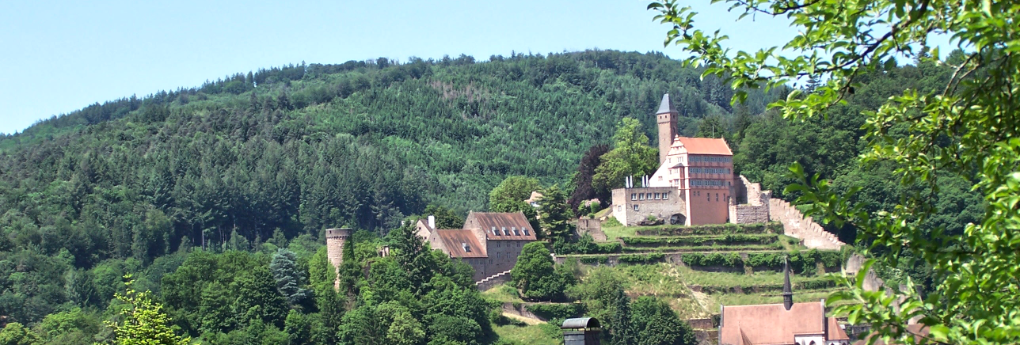
Mark Twain’s description of Hirschhorn is still as true as it was in 1878: “…Hirschhorn is best seen from a distance, down the river. Then the clustered brown towers perched on the green hilltop, and the old battlemented stone wall stretching up and over the grassy ridge and disappearing in the leafy sea beyond, make a picture whose grace and beauty entirely satisfy the eye.”
The “Lords of Hirschhorn” began building the impressive castle complex around 1250, which they expanded and rebuilt in the following centuries and also adapted to the current state of military technology. The late baptist castle was built with a square ground plan as a hillside castle and set off by a neck ditch about 16 meters deep. The mighty shield wall, one of the strongest of the Neckar valley castles, has survived to this day. In its protection stood the first buildings, of which remains of the gate tower and an early Gothic residential tower in the present-day palace building have been preserved.
In the 14th and 15th centuries, the castle was further expanded. With its sprawling outer fortifications, it was the most militarily modern castle in the Neckar valley at that time. In the 16th and 17th centuries, the castle was converted into a Renaissance palace with the construction of the so-called Hatzfeldbau as a new palace next to the older one. Terraced gardens were laid out and several farm buildings were erected, including the picturesque gatehouse of the middle castle gate.
After the death of the last Hirschhorn knight in 1632, the complex rapidly fell into disrepair until the first preservation measures began in 1884.
The newly restored castle complex still bears witness to the wealth and power of the old knightly dynasty. From here you have a magnificent view of the Neckar valley, and at the same time it is a starting point for beautiful hikes along the Neckar loop. As a guest you can be pampered in the castle hotel or visit events taking place in the castle. The old castle chapel with its valuable frescoes from the 14th century, is now used as the wedding room of the Hirschhorn registry office.
Burg Hornberg – Neckarzimmern
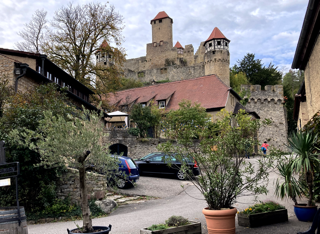 Hornberg Castle is the largest castle complex on the Neckar River. Its first mention dates back to the year 1184. The oldest owner known to us, Count Boppo von Lauffen, already owned vineyards here and even had column capitals of his mighty residential building decorated with wine motifs.
Hornberg Castle is the largest castle complex on the Neckar River. Its first mention dates back to the year 1184. The oldest owner known to us, Count Boppo von Lauffen, already owned vineyards here and even had column capitals of his mighty residential building decorated with wine motifs.
To this day, Burg Hornberg is known for its wines and still houses a historic winery. It is also home to a 4-star hotel and restaurant with a panoramic view. Another remarkable feature of Hornberg Castle is that guests can visit the almost completely preserved masonry from the Middle Ages. Furthermore, the keep, tower palaces, shield wall, embrasures from different eras, seven gates, three residential buildings, stair tower, a completely preserved chapel and much more are waiting to be explored.
In addition, Hornberg Castle is known for its reference to Goetz von Berlichingen. He acquired the castle in 1517 and lived there for 45 years, the longest period of his life, where he also dictated his life story to the priest from Neckarzimmern in his old age – the model for Goethe’s famous drama.
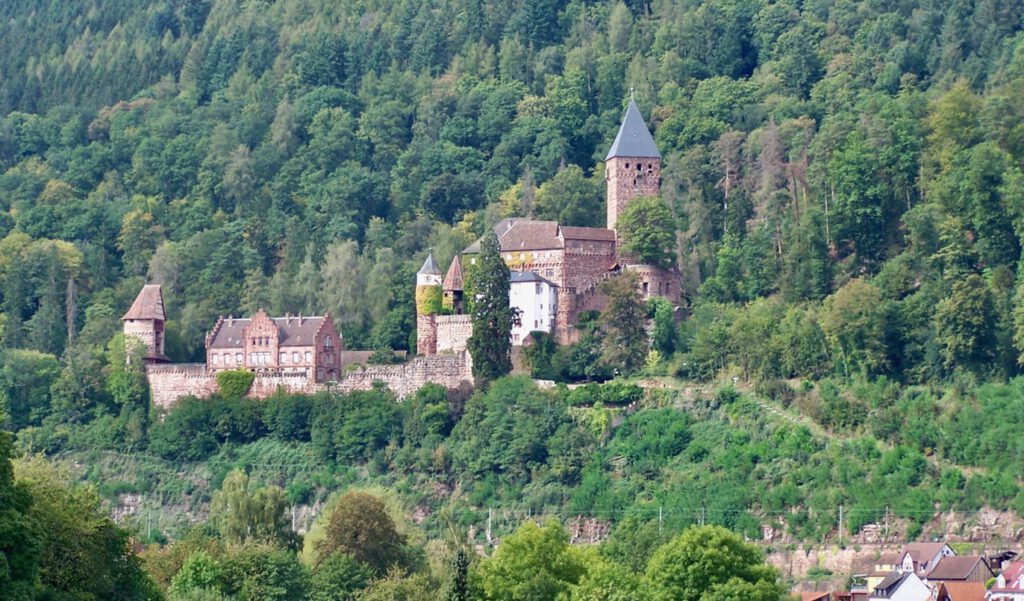
Zwingenberg Castle
The romantic castle of Zwingenberg stands high above the Neckar river between Heidelberg and Mosbach. From the castle grounds one can enjoy a magnificent view of the wild, beautiful and busy Neckar valley, the hills of the Kraichgau, and northward to the wild Odenwald and the eastern Spessart. Behind the castle the Wolfsschlucht the so called “Wolfs Gorge” invites for wonderful walks, waterfalls and scenic forest hikes.
Burg Stolzeneck
Stolzeneck Castle is located over 200 meters up on a hilltop spur that descends to the Neckar River and is separated from the plateau by a gorge, so that the fortification enjoys natural protection from several sides. It is also set off from the ridge by a deep neck ditch (dry moat). A highlight is the imposing shield wall that protects the castle on the mountain side. Hidden on the wooded mountain spur, Stolzeneck Castle can hardly be seen from the Neckar Valley. A visit to the impressive complex can be considered a real “insider tip”.
The Minneburg
The origins of the Minneburg cannot be clearly documented, but it can be assumed that it was founded in the late Staufer period. Its first mention is only documented for the year 1338 in the possession of the family Rüdt von Collenberg. Only eleven years later the castle was sold to Count Palatine Ruprecht I., who in turn pledged it to various lesser nobles. During a siege in 1622 by Bavarian troops, the castle was abandoned after being fired upon by cannons and in 1656 was partially demolished.
Burg Guttenberg – Hassmersheim
Guttenberg Castle is an intact hilltop castle above the Neckar Valley and one of the few Staufer castles to have been inhabited and completely preserved for 800 years. It was probably built from 1180 onwards. Its first documented mention dates back to the late 13th century – in 1296 the St. Nicholas Chapel below the castle is mentioned. For example, both the keep and the masonry right next to it date back to the 13th century. In the following centuries the castle was renewed and extended again and again.
Since 1449 it has been owned by the Gemmingen-Guttenberg line of the Barons of Gemmingen, who still occupy it. Already at the end of 1521 the Lords of Gemmingen joined the Reformation. In today’s territory of the Protestant Church in Baden, the family was among the first followers of Martin Luther’s teachings. Guttenberg was spared from destruction during the Peasants’ War and the Thirty Years’ War due to fortunate circumstances.
Today, visitors to Guttenberg Castle can enjoy the castle grounds, climb the keep, explore life in the knight’s castle in the castle museum and experience hearty knight’s meals in the castle tavern. From there, you can enjoy a breathtaking view of the Neckar Valley and the nearby Odenwald Forest. The German Grifenwarte (Griffin Observatory) can be visited in the castle’s kennel walls. During the season, it offers fascinating flight demonstrations of owls, eagles and vultures.